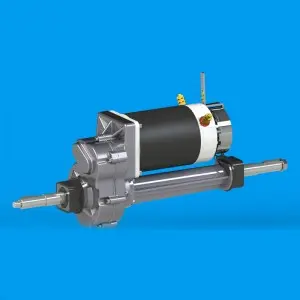The transaxle control system is an important part of the vehicle’s drivetrain and is responsible for distributing power from the engine to the wheels. When this system fails, it can cause a host of problems that affect vehicle performance and safety. Understanding the causes and potential consequences of transaxle control system failure is critical to maintaining the health and functionality of your vehicle.
What is a transaxle control system?
Before delving into potential failures of the transaxle control system, it’s important to understand its basic functions. The transaxle control system is a complex network of components that work together to regulate the transfer of power from the engine to the wheels. It consists of various sensors, solenoid valves and control modules to monitor and adjust the operation of the transaxle to ensure smooth and efficient power transmission.
The transaxle control system manages gear shifting, torque distribution and overall drivability. It plays a key role in optimizing fuel efficiency, enhancing traction control and providing a smooth driving experience. When the transaxle control system is functioning properly, the vehicle operates seamlessly, with power being transferred to the wheels in a controlled and efficient manner.
Causes of Transaxle Control System Failure
Several factors can cause a transaxle control system to malfunction. These include:
Electrical Issues: The transaxle control system relies on a network of electrical components, including sensors, wiring, and control modules. Any interruption or damage to these electrical components may cause system failure. Corrosion, loose connections, or short circuits can interfere with the proper operation of the transaxle control system.
Mechanical Failure: Over time, the transaxle’s mechanical components, such as the clutch, gears, and bearings, can wear out. If these components become damaged or worn, they can prevent the transaxle control system from operating smoothly, causing malfunctions and performance issues.
Fluid contamination: The transaxle relies on transmission fluid to lubricate its moving parts and promote smooth shifting. Contaminated or degraded transmission fluid can affect the system’s performance, causing erratic shifts, slippage and other problems.
Sensor failure: The transaxle control system relies on various sensors to monitor the vehicle’s speed, engine load and other parameters. If these sensors malfunction or provide inaccurate data, it can disrupt the system’s ability to make precise adjustments, leading to performance issues.
Consequences of Transaxle Control System Failure
When a transaxle control system fails, there can be a range of consequences that affect vehicle performance and safety. Some potential problems that may result from a faulty transaxle control system include:
Erratic shifting: One of the most common symptoms of a transaxle control system failure is erratic or delayed shifting. This can lead to erratic acceleration and difficulty maintaining a consistent speed.
Reduced fuel efficiency: A faulty transaxle control system can lead to increased fuel consumption because the system may have difficulty optimizing shifting and torque distribution. This can result in reduced fuel efficiency and higher operating costs.
Loss of Power: If the transaxle control system cannot effectively transfer power from the engine to the wheels, the vehicle may experience a loss of power and acceleration. This can affect the vehicle’s ability to perform basic maneuvers, such as merging onto a highway or climbing a steep grade.
Transmission Overheating: Transaxle control system failure can cause excessive heat to build up in the transmission. This can cause the transmission fluid to degrade more quickly, leading to further performance issues and potential damage to transmission components.
Safety issues: Failure of the transaxle control system may affect the overall safety and drivability of the vehicle. Erratic shifting and loss of power can make the vehicle more difficult to control, increasing the risk of accidents and collisions.
Solution to transaxle control system failure
Troubleshooting a transaxle control system failure requires a systematic approach to diagnosing and resolving the underlying problem. Some potential solutions to transaxle control system failures include:
Diagnostic testing: When a problem occurs with the transaxle control system, diagnostic testing must be performed to determine the specific cause of the failure. This may involve using specialized diagnostic equipment to retrieve error codes and perform system checks.
Electrical Inspection: Given the transaxle control system’s reliance on electrical components, it is important to inspect the system for any signs of electrical problems. This may involve checking for loose connections, damaged wiring, or corroded terminals that could disrupt the operation of the system.
Fluid inspection and replacement: Regular inspection and replacement of transmission oil is essential to maintain the health of the transaxle control system. If the fluid becomes contaminated or degraded, it should be flushed and replaced with fresh fluid to ensure optimal performance.
Sensor calibration and replacement: Sensor failure can seriously affect the performance of the transaxle control system. Calibrating sensors and replacing faulty sensors if necessary can help restore functionality to the system.
Mechanical Repairs: If the failure is due to a mechanical failure within the transaxle, such as worn clutch components or damaged gears, mechanical repairs may be required to restore system performance.
Software Updates: In some cases, the transaxle control system may benefit from a software update or reprogramming to resolve known issues or improve system functionality.
Professional Maintenance: Scheduled maintenance by a qualified technician can help prevent transaxle control system failure by identifying and solving potential problems before they escalate.
In summary, a faulty transaxle control system can have a significant impact on the vehicle’s performance and safety. Understanding the potential causes and consequences of such failures is critical for proactive maintenance and prompt problem resolution. By troubleshooting electrical, mechanical and fluid-related issues, as well as performing diagnostic testing and scheduled maintenance, owners can ensure optimal functionality of their transaxle control system and enjoy a smooth, safe driving experience.
Post time: Jul-22-2024


